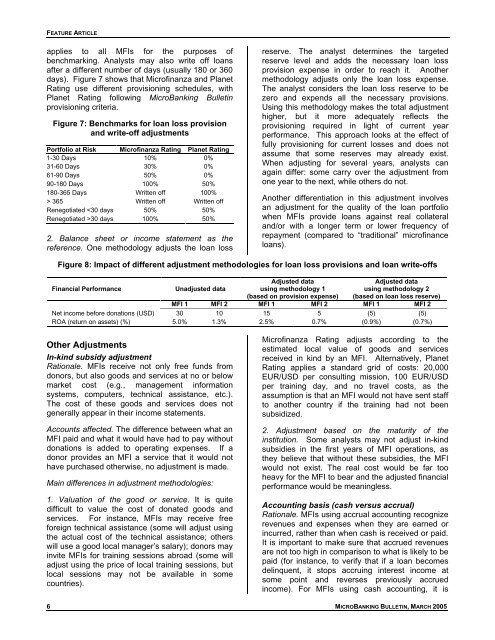Downloading - Microfinance Information Exchange
Downloading - Microfinance Information Exchange
Downloading - Microfinance Information Exchange
Create successful ePaper yourself
Turn your PDF publications into a flip-book with our unique Google optimized e-Paper software.
FEATURE ARTICLE<br />
applies to all MFIs for the purposes of<br />
benchmarking. Analysts may also write off loans<br />
after a different number of days (usually 180 or 360<br />
days). Figure 7 shows that Microfinanza and Planet<br />
Rating use different provisioning schedules, with<br />
Planet Rating following MicroBanking Bulletin<br />
provisioning criteria.<br />
Figure 7: Benchmarks for loan loss provision<br />
and write-off adjustments<br />
Portfolio at Risk Microfinanza Rating Planet Rating<br />
1-30 Days 10% 0%<br />
31-60 Days 30% 0%<br />
61-90 Days 50% 0%<br />
90-180 Days 100% 50%<br />
180-365 Days Written off 100%<br />
> 365 Written off Written off<br />
Renegotiated 30 days 100% 50%<br />
2. Balance sheet or income statement as the<br />
reference. One methodology adjusts the loan loss<br />
reserve. The analyst determines the targeted<br />
reserve level and adds the necessary loan loss<br />
provision expense in order to reach it. Another<br />
methodology adjusts only the loan loss expense.<br />
The analyst considers the loan loss reserve to be<br />
zero and expends all the necessary provisions.<br />
Using this methodology makes the total adjustment<br />
higher, but it more adequately reflects the<br />
provisioning required in light of current year<br />
performance. This approach looks at the effect of<br />
fully provisioning for current losses and does not<br />
assume that some reserves may already exist.<br />
When adjusting for several years, analysts can<br />
again differ: some carry over the adjustment from<br />
one year to the next, while others do not.<br />
Another differentiation in this adjustment involves<br />
an adjustment for the quality of the loan portfolio<br />
when MFIs provide loans against real collateral<br />
and/or with a longer term or lower frequency of<br />
repayment (compared to “traditional” microfinance<br />
loans).<br />
Figure 8: Impact of different adjustment methodologies for loan loss provisions and loan write-offs<br />
Financial Performance<br />
Unadjusted data<br />
Adjusted data<br />
using methodology 1<br />
(based on provision expense)<br />
Adjusted data<br />
using methodology 2<br />
(based on loan loss reserve)<br />
MFI 1 MFI 2 MFI 1 MFI 2 MFI 1 MFI 2<br />
Net income before donations (USD) 30 10 15 5 (5) (5)<br />
ROA (return on assets) (%) 5.0% 1.3% 2.5% 0.7% (0.9%) (0.7%)<br />
Other Adjustments<br />
In-kind subsidy adjustment<br />
Rationale. MFIs receive not only free funds from<br />
donors, but also goods and services at no or below<br />
market cost (e.g., management information<br />
systems, computers, technical assistance, etc.).<br />
The cost of these goods and services does not<br />
generally appear in their income statements.<br />
Accounts affected. The difference between what an<br />
MFI paid and what it would have had to pay without<br />
donations is added to operating expenses. If a<br />
donor provides an MFI a service that it would not<br />
have purchased otherwise, no adjustment is made.<br />
Main differences in adjustment methodologies:<br />
1. Valuation of the good or service. It is quite<br />
difficult to value the cost of donated goods and<br />
services. For instance, MFIs may receive free<br />
foreign technical assistance (some will adjust using<br />
the actual cost of the technical assistance; others<br />
will use a good local manager’s salary); donors may<br />
invite MFIs for training sessions abroad (some will<br />
adjust using the price of local training sessions, but<br />
local sessions may not be available in some<br />
countries).<br />
Microfinanza Rating adjusts according to the<br />
estimated local value of goods and services<br />
received in kind by an MFI. Alternatively, Planet<br />
Rating applies a standard grid of costs: 20,000<br />
EUR/USD per consulting mission, 100 EUR/USD<br />
per training day, and no travel costs, as the<br />
assumption is that an MFI would not have sent staff<br />
to another country if the training had not been<br />
subsidized.<br />
2. Adjustment based on the maturity of the<br />
institution. Some analysts may not adjust in-kind<br />
subsidies in the first years of MFI operations, as<br />
they believe that without these subsidies, the MFI<br />
would not exist. The real cost would be far too<br />
heavy for the MFI to bear and the adjusted financial<br />
performance would be meaningless.<br />
Accounting basis (cash versus accrual)<br />
Rationale. MFIs using accrual accounting recognize<br />
revenues and expenses when they are earned or<br />
incurred, rather than when cash is received or paid.<br />
It is important to make sure that accrued revenues<br />
are not too high in comparison to what is likely to be<br />
paid (for instance, to verify that if a loan becomes<br />
delinquent, it stops accruing interest income at<br />
some point and reverses previously accrued<br />
income). For MFIs using cash accounting, it is<br />
6 MICROBANKING BULLETIN, MARCH 2005

















